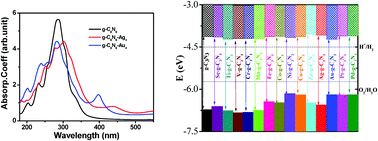Improving the photocatalytic activity of s-triazine based graphitic carbon nitride through metal decoration: an ab initio investigation†
Abstract
Graphitic carbon nitride based semiconductor materials are found to be potential photocatalysts for generating hydrogen through solar water splitting. Through more accurate hybrid density functional theory calculations, we attempted to tune the electronic band structure of poly s-triazine based graphitic carbon nitride by decorating it with different metal atoms and clusters for improving its visible light absorption efficiency. For deposition on the two-dimensional carbon nitride surface, a range of metals have been considered which include all the 3d transition metals and the noble metals (Ag, Au, Pt and Pd). Our study reveals that though the band gaps of all the metal decorated systems were less than that of pristine carbon nitride, in most of the cases, metal decoration leads to the formation of mid gap impurity states, which can hinder the mobility of charge carriers. However, in the case of Ag and its four atom cluster deposited systems, no mid gap states were observed. In all the metal decorated systems, the measured band edge potentials were also found to satisfy the thermodynamic criterion for overall water splitting. The calculated optical absorption spectra show a shift in the absorption band towards the visible region upon metal decoration. Our results indicate that among all the considered metal atoms silver is the preferred candidate for deposition on the carbon nitride surface for improved photocatalytic activity.


 Please wait while we load your content...
Please wait while we load your content...